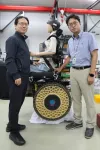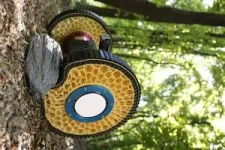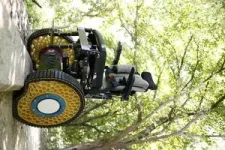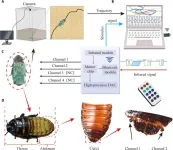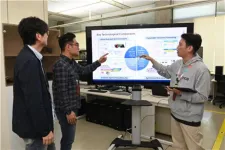(Press-News.org) A new technology for wheels and mobile systems, necessary for overcoming various obstacles in daily life such as stairs or rocks by adjusting the stiffness of the wheel in real time, has been developed for the first time in the world. This noble technology is anticipated to find wide applications in various moving vehicles equipped with wheels, where overcoming terrain obstacles is essential.
The Korea Institute of Machinery and Materials (President Seog-Hyeon Ryu, hereinafter referred to as KIMM), an institute under the jurisdiction of the Ministry of Science and ICT, announced that it has developed, for the first time in the world, a variable-stiffness morphing wheel inspired by the surface tension of a liquid droplet, and successfully applied the technology to a mobile system
The morphing wheel developed by the research team lead by Principal Researcher Sung-Hyuk Song and Dong Il Park, Head of the Advanced Robotics Research Center of the KIMM’s Research Institute of AI Robotics, is a wheel and modularization system capable of altering the stiffness of the wheel by simply changing the surface tension applicable to the smart chain blocks without having to use complex machinery or sensors. The wheel can operate as a rigid, circular wheel in a regular driving mode and then switch to a soft, deformable state when rolling over obstacles, depending on the height and shape of those obstacles.
There already have been technologies for designing the inside of wheels as flexible structures, like non-pneumatic tires. However, the limitation of these conventional technologies is that the wheels are continuously deformed even when driving on flat surfaces, which hinders driving efficiency and stability and generates noise. On the other hand, the stiffness of the wheel developed by the KIMM’s research team can be adjusted between a rigid state for fast movement on flat ground and a soft, deformable state for overcoming obstacles.
The morphing wheel developed by the KIMM’s research team is composed of a smart chain block and a flexible structure. The outermost edge of the wheel consists of a smart chain block, and a wire spoke* structure for controlling the surface tension of the smart chain block is connected to the hub structure of the wheel. When the hub structure rotates or the distance changes, the connected wire spoke structure is either pulled tightly or loosened, thereby altering the surface tension of the smart chain block structure.
* Wire spokes: Wire spokes connect the wheel hub, which is located at the center of rotation of the wheel and generates rotational force, to the wheel’s outermost structure.
If the wire spokes pull the smart chain blocks inward, the traction force at the outermost smart chain structure increases. This is similar to a situation where an increment in the surface tension of a liquid droplet leads to an increase in the net force pulling the outermost liquid molecules, which results in the liquid droplet stably maintaining a circular shape. Conversely, if the wire spoke structure loosens, the rigidity declines.
The KIMM’s research team recently succeeded in developing the modularization technology for easily applying the wheel to a wide range of mobile systems. A miniaturized, light-weight version of the variable-stiffness mechanism was inserted into the interior of the wheel. Then, a modularized version of the wheel was applied to various mobile systems such as a two-wheeled wheelchair.
In this two-wheeled wheelchair system, the stiffness of the wheel can be changed in real time, allowing the wheelchair to move in a stable manner and alter directions even when space is limited. Additionally, the wheelchair can roll over obstacles such as rocks or 18-centimeter-high stairs. Meanwhile, by applying the wheel to a four-wheeled mobile system, the KIMM’s research team confirmed that the wheel can also stably overcome obstacles that are 1.3 times higher than the wheel radius.
Principal Researcher Sung-Hyuk Song of the KIMM commented, “One of the problems associated with quadrupedal and bipedal walking robots for overcoming obstacles is that movement efficiency is relatively low on flat surfaces, and that shaking inevitably occurs in the moving state.” Song added, “The newly developed morphing wheel is significantly meaningful in that it is capable of overcoming obstacles while at the same time maintaining high movement efficiency comparable to conventional wheels.”
Dong Il Park, Head of the KIMM’s Advanced Robotics Research Center, was quoted as saying, “This new technology for morphing wheels inspired by surface tension can help to overcome the limitations of conventional mechanical devices such as leg-type robots and wheel clusters for overcoming obstacles.” Park added, “It will likely find applications in a wide range of fields including wheelchairs, mobile robots, and personal mobility capable of overcoming obstacles.”
Meanwhile, this research was published as the cover article in the August 2024 issue of “Science Robotics (IF 26.1),” a leading journal in the robotics sector and a sister journal of “Science.” The research was supported by the project “Independent activity supporting robot for the paraplegic people (led by Dong Il Park, Head of the KIMM’s Advanced Robotics Research Center),” and funded by a major project of the KIMM (NK250F).
###
The Korea Institute of Machinery and Materials (KIMM) is a non-profit government-funded research institute under the Ministry of Science and ICT. Since its foundation in 1976, KIMM is contributing to economic growth of the nation by performing R&D on key technologies in machinery and materials, conducting reliability test evaluation, and commercializing the developed products and technologies.
END
KIMM develops wheel that alters stiffness in real time based on situation
World’s First: KIMM develops “Stiffness-variable wheel” capable of rolling over rocks and climbing the stairs
2024-09-02
ELSE PRESS RELEASES FROM THIS DATE:
Blood stem cell breakthrough could transform bone marrow transplants
2024-09-02
Melbourne researchers have made a world first breakthrough into creating blood stem cells that closely resemble those in the human body. And the discovery could soon lead to personalised treatments for children with leukaemia and bone marrow failure disorders.
The research, led by Murdoch Children’s Research Institute (MCRI) and published in Nature Biotechnology, has overcome a major hurdle for producing human blood stem cells, which can create red cells, white blood cells and platelets, that closely match those in the human embryo.
MCRI Associate Professor Elizabeth Ng said the team had made a significant discovery in human blood stem ...
Rare genetic variants linked to bicuspid aortic valve disease in young adults identified by UTHealth Houston researchers
2024-09-02
Genetic variants linked to a rare form of bicuspid aortic valve disease that affects young adults and can lead to dangerous and potentially life-threatening aortic complications have been identified by researchers at UTHealth Houston.
The study was published today in the American Journal of Human Genetics.
“We previously found that young individuals who present due to early onset thoracic aortic dissections are more likely to have bicuspid aortic valves and more likely to have rare variants in bicuspid aortic valve-associated genes,” said Siddharth Prakash, MD, PhD, co-principal investigator of the study and associate professor of medical ...
Locomotion control of cyborg insects by charge-balanced biphasic electrical stimulation
2024-09-02
A research paper by scientists at Beijing Institute of Technology proposed a universal system for remote signal output control using infrared signals.
The new research paper, published on Jul. 05 in the journal Cyborg and Bionic Systems, proposed a system that integrates high-precision digital-to-analog converters capable of generating customized waveform electrical stimulation signals within defined ranges. This enhances the accuracy of locomotion control in cyborg insects while maintaining real-time control and dynamic parameter adjustment. The proposed system is verified by experiments.
The integration of electronic stimulation devices with insects in ...
Depressed adolescents twice as likely to vape
2024-09-02
A study on vaping behaviour among Australian high school students has found those who reported severe depressive symptoms were over twice as likely to have tried e-cigarettes, compared to those reporting no depressive symptoms.
Data showed overall higher e-cigarette use among those with poorer mental health, including severe depressive symptoms, moderate and high stress, and low wellbeing.
The findings show a critical need for effective mental health support at the same time as vaping prevention during early adolescence -- when these issues first emerge.
The researchers surveyed over ...
Helping public decision-making with AI-based policy intelligence system
2024-09-02
Korean researchers are pushing for a new AI-based policy intelligence research project that can assist the public decision-making and policy execution of domestic and foreign local governments.
Electronics and Communications Research Institute (ETRI) announced on July 1 that they have decided to establish a cooperative system with the International Institute for Applied Systems Analysis (IIASA)1) to conduct further research regarding the development of an AI policy intelligence system that can assist public policy decision-making.
1) International Institute for Applied Systems Analysis (IIASA): An independent international research institute located ...
Pulmonary vein isolation vs sham intervention in symptomatic atrial fibrillation
2024-09-02
About The Study: Pulmonary vein isolation resulted in a statistically significant and clinically important decrease in atrial fibrillation burden at 6 months, with substantial improvements in symptoms and quality of life, compared with a sham procedure.
Corresponding Authors: To contact the corresponding authors, email Rick A. Veasey, MD, (rick.veasey@nhs.net) and Rajdip Dulai, MBBS, (rajdip.dulai.21@ucl.ac.uk)
To access the embargoed study: Visit our For The Media website at this link https://media.jamanetwork.com/
(doi:10.1001/jama.2024.17921)
Editor’s ...
Lesion-level effects of LDL-C–lowering therapy in patients with acute myocardial infarction
2024-09-02
About The Study: At the lesion level, very intensive lipid-lowering therapy induced substantially greater percent atheroma volume regression than described in previous vessel-level analyses. Compared with statin therapy alone, alirocumab treatment was associated with greater enlargement of the lesion minimum lumen area and more frequent transition of presumably high-risk plaque phenotypes into more stable, less lipid-rich plaque phenotypes.
Corresponding Author: To contact the corresponding author, Lorenz ...
How cells control gene expression by cleaning up their mistakes
2024-09-02
Alternative splicing is a genetic process where different segments of genes are removed, and the remaining pieces are joined together during transcription to messenger RNA (mRNA). This mechanism increases the diversity of proteins that can be generated from genes, by assembling sections of genetic code into different combinations. This is believed to enhance biological complexity by allowing genes to produce different versions of proteins, or protein isoforms, for many different uses.
New research from the University of Chicago suggests that alternative splicing may have an even greater influence on biology than just by creating new protein isoforms. The ...
Global South cities lack cooling green spaces
2024-09-02
Cities in the Global South are more exposed to extreme heat because they lack cooling green spaces, new research shows.
The study found that Global South cities have just 70% of the “cooling capacity” provided by urban greenery in the Global North.
With temperatures rising, combined with the “urban heat island” effects that make cities hotter than rural areas, heat-related illness and death in cities are becoming more common.
Urban green spaces can help reduce this risk, cooling down outdoor environments and providing vital refuges.
The research – led by an international team including Nanjing, Exeter, Aarhus and North Carolina State universities – ...
The risk of global water scarcity is greater when accounting for the origin of rain.
2024-09-02
Securing the world's water supply is one of the greatest challenges of our time. Research at Stockholm University is now presenting an alternative method for quantifying the global risk of water scarcity. Results indicate higher risks to water supply than previously expected if accounting for the environmental conditions and governability where rain is produced.
The common idea of global water supply is rain falling on the earth's surface and then stored in aquifers, lakes, and rivers. This idea is usually used to assess water security and the risk of water scarcity. However, a new study published in Nature Water shows how the water risks are dependent on governance ...
LAST 30 PRESS RELEASES:
Air pollution exposure and birth weight
Obstructive sleep apnea risk and mental health conditions among older adults
How talking slows eye movements behind the wheel
The Ceramic Society of Japan’s Oxoate Ceramics Research Association launches new international book project
Heart-brain connection: international study reveals the role of the vagus nerve in keeping the heart young
Researchers identify Rb1 as a predictive biomarker for a new therapeutic strategy in some breast cancers
Survey reveals ethical gaps slowing AI adoption in pediatric surgery
Stimulant ADHD medications work differently than thought
AI overestimates how smart people are, according to HSE economists
HSE researchers create genome-wide map of quadruplexes
Scientists boost cell "powerhouses" to burn more calories
Automatic label checking: The missing step in making reliable medical AI
Low daily alcohol intake linked to 50% heightened mouth cancer risk in India
American Meteorological Society announces Rick Spinrad as 2026 President-Elect
Biomass-based carbon capture spotlighted in newly released global climate webinar recording
Illuminating invisible nano pollutants: advanced bioimaging tracks the full journey of emerging nanoscale contaminants in living systems
How does age affect recovery from spinal cord injury?
Novel AI tool offers prognosis for patients with head and neck cancer
Fathers’ microplastic exposure tied to their children’s metabolic problems
Research validates laboratory model for studying high-grade serous ovarian cancer
SIR 2026 delivers transformative breakthroughs in minimally invasive medicine to improve patient care
Stem Cell Reports most downloaded papers of 2025 highlight the breadth and impact of stem cell research
Oxford-led study estimates NHS spends around 3% of its primary and secondary care budget on the health impacts of heat and cold in England
A researcher’s long quest leads to a smart composite breakthrough
Urban wild bees act as “microbial sensors” of city health.
New study finds where you live affects recovery after a hip fracture
Forecasting the impact of fully automated vehicle adoption on US road traffic injuries
Alcohol-related hospitalizations from 2016 to 2022
Semaglutide and hospitalizations in patients with obesity and established cardiovascular disease
Researchers ‘listen in’ to embryo-mother interactions during implantation using a culture system replicating the womb lining
[Press-News.org] KIMM develops wheel that alters stiffness in real time based on situationWorld’s First: KIMM develops “Stiffness-variable wheel” capable of rolling over rocks and climbing the stairs
